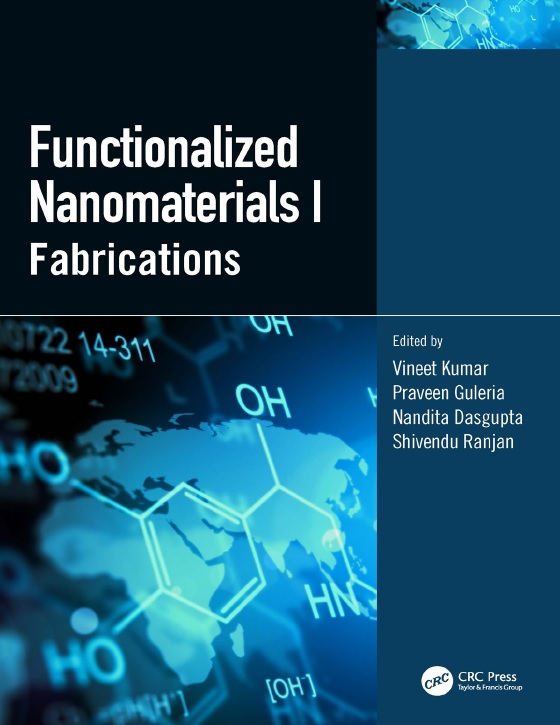Edited By Vineet Kumar, Praveen Guleria, Nandita Dasgupta, Shivendu Ranjan

Contents
2 Facile Chemical Fabrication of Designer Biofunctionalized Nanomaterials ……………………………………………………………….25 A.H. Sneharani and K. Byrappa 3 Functionalized Nanogold: Its Fabrication and Needs ………………………………………………………………………………………………..35 Biswajit Choudhury 4 Biogenic Synthesis of Silver Nanoparticles and Their Applications ……………………………………………………………………………57 G. Krishna, V. Pranitha, Reeja Sundaram, and M.A. Singara Charya 5 Nanostructure Thin Films: Synthesis and Different Applications………………………………………………………………………………71 Ho Soon Min, Debabrata Saha, J.M. Kalita, M.P. Sarma, Ayan Mukherjee, Benjamin Ezekoye, Veronica A. Ezekoye, Ashok Kumar Sharma, Manesh A. Yewale, Ayaz Baayramov, and Trilok Kumar Pathak 6 Carbon Nanotubes: Preparation and Surface Modifcation for Multifunctional Applications…………………………………….83 Jingyao Sun, Jing Zhu, Merideth A. Cooper, Daming Wu, and Zhaogang Yang 7 Carbon Dots: Scalable Synthesis, Physicochemical Properties, and Biomedical Application…………………………………….115 Savita Chaudhary and Pooja Chauhan 8 Investigations on Exotic Forms of Carbon: Nanotubes, Graphene, Fullerene, and Quantum Dots ……………………………125 Mahe Talat, Kalpana Awasthi, Vikas Kumar Singh, and O.N. Srivastava 9 Nanodiamonds and Other Organic Nanoparticles: Synthesis and Surface Modifcations …………………………………………135 Navneet Kaur, Chander Prakash, Aman Bhalla, and Ganga Ram Chaudhary 10 Polymeric Nanoparticles: Preparation and Surface Modifcation…………………………………………………………………………….161 A. Chander, R. Santhosh, S. Avinash, M. Priyanka, T. Guping, B. Murali, R. Karthik, and S.N. Rathe 11 Cellulose Fibers and Nanocrystals: Preparation, Characterization, and Surface Modifcation…………………………………171 Djalal Trache, Ahmed Fouzi Tarchoun, Mehdi Derradji, Oussama Mehelli, M. Hazwan Hussin, and Wissam Bessa 12 Protein and Peptide Nanoparticles: Preparation and Surface Modifcation……………………………………………………………..191 K. Vinay, S. Neha, and S. S. Maitra 13 Recent Advances in Glycolipid Biosurfactants at a Glance: Biosynthesis, Fractionation, Purifcation, and Distinctive Applications……………………………………………………………………………………………………………………………………205 Rohini Kanwar and S.K. Mehta 14 Insight into Covalent/Non-Covalent Functionalization of Silica Nanoparticles for Neurotherapeutic and Neurodiagnostic Agents …………………………………………………………………………………………………………………………………..215 Anup K. Srivastava, Babita Kaundal, Garima Khanna, Subhasree Roy Choudhury, and Surajit Karmakar 15 Fabrication and Functionalization of Ionic Liquids…………………………………………………………………………………………………225
Neha Jindal and Kulvinder Singh
16 Fabrication and Functionalization of Other Inorganic Nanoparticles and Nanocomposites ……………………………………..239 Kiranmai Mandava and Uma Rajeswari B. 17 Clay/Non-Ionic Surfactant Hybrid Nanocomposites………………………………………………………………………………………………..269 Giuseppe Cavallaro, Giuseppe Lazzara, Stefana Milioto, Filippo Parisi, and Luciana Sciascia 18 Microorganism-Mediated Functionalization of Nanoparticles for Different Applications…………………………………………279 Maheshkumar Prakash Patil and Gun-Do Kim 19 Nanotechnology in Molecular Targeting, Drug Delivery, and Immobilization of Enzyme(s)……………………………………..299 Abhishek Sharma, Kishore Kumar, Tanvi Sharma, Shweta Sharma, and Shamsher S. Kanwar Index…………………………………………………………………………………………..309
Preface
The demand for affordable, environment-friendly, and sustainable materials has encouraged scientists in different felds to draw inspiration from nature in developing materials with unique properties, such as miniaturization, hierarchical organization, and adaptability. Together with the exceptional properties of nanomaterials, the feld of functionalized nanomaterials has taken a huge leap over the past century. On one hand, the sophistication of hierarchical structures endows biological systems with multi-functionality. Simultaneously, synthetic control on the creation of nanomaterials permits/warrants the design of materials with specifc functionalities. Biological templates are architectures that behave as containers such as viral capsids. Specifcally, these biological containers can function as carriers for DNA assays, immunoassays, drugs, and catalysts, and can also be used in novel material synthesis. In recent times, researchers have also used biological macromolecular assemblies as templates for the construction of novel functional nanomaterials. The human biological system is made up of a nanoscale self-assembly of biological molecules. Functionalized nanomaterials have been applied for the fabrication of organs-on-chips and smart robotic devices. Thus, by varying the type of functionalization by chemistry, nanomaterials can be intentionally designed for several distinct applications.
This book contains nineteen chapters describing the basic principles, trends, and challenges in the synthesis of functionalized nanomaterials. Chapters 1 and 2 are introductory chapters that provide a basic understanding of the strategies available for the functionalization of nanomaterials and their characterization. Chapters 3–5 discuss the functionalization of metallic nanomaterials. Chapter 6 describes the formation of nanoflms as and/or using functionalized nanomaterials. Chapters 7–9 provide information regarding the functionalization of carbon-based nanomaterials and quantum dots. Currently, carbon-based nanomaterials and quantum dots are commonly used nanomaterials for industrial applications. Chapters 10–13 describe the functionalization of polymeric nanomaterials including biological nanomaterials that are very useful for drug delivery and tissue engineering applications. Chapters 14–17 focus over the functionalization of silica, clay, and other inorganic nanocomposites that are useful for tissue engineering, material chemistry, and environmental applications. Chapter 18 discusses the use of microorganisms to functionalize nanomaterials for various applications. Chapter 19 discusses the application of nanomaterials for drug delivery, enzyme immobilization, and molecular targeting applications. Collectively, this book addresses critical issues in the functionalization of nanomaterials, such as the way in which chemical functionalization, green synthesis, and bio-inspired synthesis have evolved, and the key benefts of functionalized nanomaterials over conventional synthetic approaches. It also summarizes the chemistry behind functionalized nanomaterials.
This book will be benefcial to help undergraduate and graduate students understand the detailed concept of functionalized nanomaterials and the strategies of nanomaterial fabrication. Doctoral and post-doctoral scholars will beneft from the use of this book through learning the basics of techniques, recent advancements, challenges, and opportunities in this feld. This book will provide critical and comparative data for nanotechnologists and thus it will be benefcial for scientists and researchers working in this feld. It will also be benefcial for academicians by providing the basics of the fabrication of functionalized nanomaterials, as many universities throughout the world include nano-biotechnology as a subject that cannot be completed without bio-inspired nanomaterials. Additionally, this book will also be of value to industry personnel, journalists, policy makers, and the common public, as it helps understand functionalized nanomaterials in detail and in depth.
